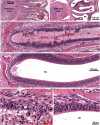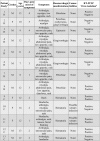Infectious Chikungunya Virus in the Saliva of Mice, Monkeys and Humans
- PMID: 26447467
- PMCID: PMC4598147
- DOI: 10.1371/journal.pone.0139481
Infectious Chikungunya Virus in the Saliva of Mice, Monkeys and Humans
Abstract
Chikungunya virus (CHIKV) is a reemerging, ordinarily mosquito-transmitted, alphavirus that occasionally produces hemorrhagic manifestations, such as nose bleed and bleeding gums, in human patients. Interferon response factor 3 and 7 deficient (IRF3/7-/-) mice, which are deficient for interferon α/β responses, reliably develop hemorrhagic manifestations after CHIKV infection. Here we show that infectious virus was present in the oral cavity of CHIKV infected IRF3/7-/- mice, likely due to hemorrhagic lesions in the olfactory epithelium that allow egress of infected blood into the nasal, and subsequently, oral cavities. In addition, IRF3/7-/- mice were more susceptible to infection with CHIKV via intranasal and oral routes, with IRF3/7-/- mice also able to transmit virus mouse-to-mouse without an arthropod vector. Cynomolgus macaques often show bleeding gums after CHIKV infection, and analysis of saliva from several infected monkeys also revealed the presence of viral RNA and infectious virus. Furthermore, saliva samples collected from several acute CHIKV patients with hemorrhagic manifestations were found to contain viral RNA and infectious virus. Oral fluids can therefore be infectious during acute CHIKV infections, likely due to hemorrhagic manifestations in the oral/nasal cavities.
Conflict of interest statement
Figures




Similar articles
-
Interferon response factors 3 and 7 protect against Chikungunya virus hemorrhagic fever and shock.J Virol. 2012 Sep;86(18):9888-98. doi: 10.1128/JVI.00956-12. Epub 2012 Jul 3. J Virol. 2012. PMID: 22761364 Free PMC article.
-
Chikungunya virus transmission between Aedes albopictus and laboratory mice.Parasit Vectors. 2016 Oct 19;9(1):555. doi: 10.1186/s13071-016-1838-1. Parasit Vectors. 2016. PMID: 27760560 Free PMC article.
-
Assessment of the transmission of live-attenuated chikungunya virus vaccine VLA1553 by Aedes albopictus mosquitoes.Parasit Vectors. 2025 May 12;18(1):171. doi: 10.1186/s13071-025-06789-w. Parasit Vectors. 2025. PMID: 40355954 Free PMC article.
-
Chikungunya virus and its mosquito vectors.Vector Borne Zoonotic Dis. 2015 Apr;15(4):231-40. doi: 10.1089/vbz.2014.1745. Epub 2015 Feb 12. Vector Borne Zoonotic Dis. 2015. PMID: 25674945 Review.
-
Animal Models of Chikungunya Virus Infection and Disease.J Infect Dis. 2016 Dec 15;214(suppl 5):S482-S487. doi: 10.1093/infdis/jiw284. J Infect Dis. 2016. PMID: 27920178 Free PMC article. Review.
Cited by
-
Oropouche virus detection in saliva and urine.Mem Inst Oswaldo Cruz. 2020 Feb 27;115:e190338. doi: 10.1590/0074-02760190338. eCollection 2020. Mem Inst Oswaldo Cruz. 2020. PMID: 32130368 Free PMC article.
-
Detection of chikungunya virus in saliva and urine.Virol J. 2016 Jun 16;13:102. doi: 10.1186/s12985-016-0556-9. Virol J. 2016. PMID: 27306056 Free PMC article.
-
Prevalence of arboviruses and other infectious causes of skin rash in patients treated at a tertiary health unit in the Brazilian Amazon.PLoS Negl Trop Dis. 2022 Oct 13;16(10):e0010727. doi: 10.1371/journal.pntd.0010727. eCollection 2022 Oct. PLoS Negl Trop Dis. 2022. PMID: 36228027 Free PMC article.
-
Boosting can explain patterns of fluctuations of ratios of inapparent to symptomatic dengue virus infections.Proc Natl Acad Sci U S A. 2021 Apr 6;118(14):e2013941118. doi: 10.1073/pnas.2013941118. Proc Natl Acad Sci U S A. 2021. PMID: 33811138 Free PMC article.
-
Salivary detection of Chikungunya virus infection using a portable and sustainable biophotonic platform coupled with artificial intelligence algorithms.Sci Rep. 2024 Sep 16;14(1):21546. doi: 10.1038/s41598-024-71889-z. Sci Rep. 2024. PMID: 39278957 Free PMC article.
References
-
- Van Bortel W, Dorleans F, Rosine J, Blateau A, Rousset D, Matheus S, et al. Chikungunya outbreak in the Caribbean region, December 2013 to March 2014, and the significance for Europe. Euro Surveill. 2014;19: 17–27. - PubMed
Publication types
MeSH terms
Substances
Grants and funding
LinkOut - more resources
Full Text Sources
Other Literature Sources
Medical

